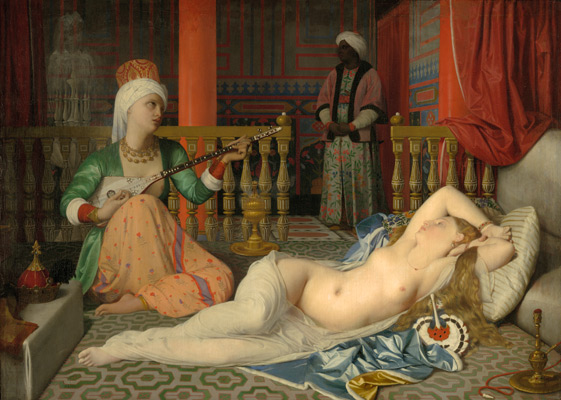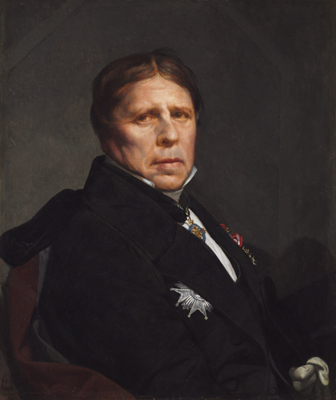Jean-Auguste-Dominique Ingres (1780–1867) was an accomplished and prolific painter and draftsman, a key figure in the neoclassical movement, and an avid interpreter of history and antiquity. Fittingly, he was also keen on self-editing.
“Ingres was an obsessive draftsman and revisionist,” said Elizabeth Rudy, the museums’ Cunningham Assistant Curator of European Art. With 11 of the artist’s works—including studies—currently on view, the Harvard Art Museums are uniquely positioned as a site to examine the multiple stages and styles of Ingres’s art. Indeed, Rudy said, “we have one of the best collections of his works outside of France.”
As a young student in Rome, Ingres produced sought-after portraits of elite French and English expatriates; these drawings provided his primary source of income. Examples include Portrait of Augustin Jordan and His Daughter Adrienne (1817) and Portrait of Mme. Augustin Jordan and Her Son Gabriel (1817). (A third example, Portrait of Mrs. George Vesey and Her Daughter Elizabeth Vesey, later Lady Colthurst (1816), will go on view this month.)
Portrait of the Family of Lucien Bonaparte (1815) was Ingres’s largest portrait drawing, commissioned by Lucien Bonaparte’s second wife, Alexandrine, to depict her family, which included the eight children from her and Lucien’s two combined households. Lucien and his mother are depicted in the background by two busts on pedestals, in the style of a Roman emperor and empress.
While the drawing bears meticulous detail, there is but one extant preparatory study for it—a noteworthy fact, Rudy said, given Ingres’s common practice of creating numerous studies for important works.
The nearby Study for “Roger Freeing Angelica” (1818) and Study for the Portrait of Madame Othenin d'Haussonville (1842–45), on the other hand, have clearly survived the test of time. In the latter, a partially completed sketch, Ingres’s handwritten notes reveal how he planned future amendments: “plus de mouvement” (more movement), for example, is jotted in graphite to the right of the figure. “We wanted to include this study to help visitors think about how Ingres didn’t always draw in the same, very precise way,” Rudy said.
Two studies for The Martyrdom of Saint Symphorien provide a glimpse into Ingres’s preparation for his monumental altarpiece at the cathedral of Autun, France, a work that took him 10 years to complete. An 1827 modello, or oil study, which is on loan to the museums, depicts Saint Symphorien with his arms tied behind his back—a markedly different posture from that of Ingres’s later studies in oil, graphite, and red chalk. In those studies, from 1833, the saint’s arms are outstretched in a position that mirrors his mother’s body language. (She is the figure in the top left of the canvas.) It’s similar to the final rendering of the saint that ultimately appears in Autun.
“What’s fantastic about having the opportunity to view different studies side by side is that we can see how many aspects of the composition changed, and how many did not,” Rudy said. “We can also see how Ingres is working within the category of an oil study to explore very distinct things; in one case, he is establishing the overall composition and structure of the scene, and in the other, he is working to set the specific poses and expressions of his figures.”
A number of completed paintings demonstrate Ingres’s success with depicting the human form and his interest in relationships between individuals. In Raphael and the Fornarina (1814), Ingres portrays his artistic hero, Raphael, in the process of creating a work of art. However, Raphael is “shown casting an amorous gaze at his own creation—his drawing—rather than at the woman on his lap,” Rudy said. Odalisque with a Slave (1839–40) earned Ingres attention for both the icily erotic relationships between the three figures as well as the Middle Eastern setting, a popular motif at the time.
Ingres’s 1859 Self-Portrait may be his only painting made directly from a photographic source, though he kindly gave himself brown hair rather than gray and added various medals to reflect his many accomplishments.
While it may seem as if Ingres was boosting his stature for posterity, the artist was in fact “a major celebrity” by this point, Rudy said. “His influence in the 19th century was tremendous.” With such an extensive—and wide-ranging—collection of Ingres’s work, the Harvard Art Museums are simply extending the artist’s reach beyond his lifetime.






